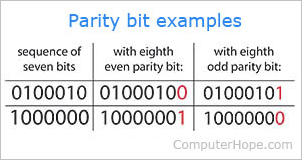Parity

In general, parity is the quality of being even or odd. In computer science, a parity check, also called VRC (Vertical Redundancy Check), is a data validation technique. It is especially useful when data is transmitted or being read from a storage medium. The check is based on a parity bit, a single bit of metadata indicating whether the sum of the data bits is even or odd. For example, if a binary stream contains an even amount of "1's" and the parity bit is odd, the computer would produce an error. The image shows 7-bit binary numbers with an eighth parity bit attached.
In the past, most memory manufacturers offered both parity and non-parity RAM (Random-Access Memory) chips, with parity RAM using a ninth parity bit for every eight-bit byte. Modern computers which require error-checking at the hardware level may use ECC (Error-Correcting Code) RAM, which uses a more complex form of error checking.
BERT, Checksum, CRC, ECC, Error control, LRC, Mark parity, Memory terms, No-parity, Parity bit, Serial, Space parity
